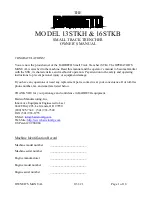
Safety Precautions
LOGIQ 500 Basic Users Manual
2233658–100 Rev. 0
2–5
Related Hazards (cont’d)
A damaged probe can also increase the risk of electric shock if
conductive solutions come in contact with internal live parts.
Inspect probes often for cracks or openings in the housing and
holes in and around the acoustic lens or other damage that
could allow liquid entry. Become familiar with the probe’s use
and care precautions outlined in
Probes and Biopsy.
Ultrasound energy, even at diagnostic levels, is capable of
damaging sensitive tissues if adequate precautions are not
followed. The wrong combination of equipment settings, probe
positioning, and tissue type can result in injury. Please become
thoroughly familiar with equipment controls that affect acoustic
output levels as well as the output display.
Follow the principle of as low as reasonably achievable
(ALARA) when scanning a patient. During each ultrasound
examination, the clinical user is expected to weigh the medical
benefit of the diagnostic information obtained against the risk of
potential harmful effects. Once an optimal image is achieved
the need for increasing acoustic output or prolonging the
exposure cannot be justified.
It is recommended that all users receive proper training in
applications before performing them in a clinical setting. Please
contact the local GE representative for training assistance.
ALARA training is provided by GE Application Specialists.
Electrical
Hazard
Acoustic
Output
Hazard
Training
















































